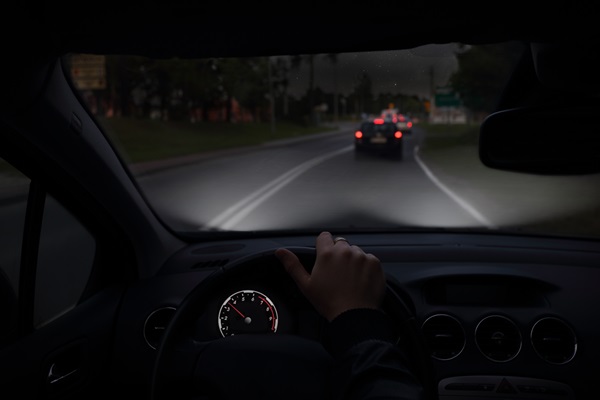
It's November, and Daylight Saving Time has already ended for the year. As such, the days are naturally getting shorter. So, what does this mean for road safety? With fewer daylight hours comes limited visibility and the risk of drowsy driving, both of which are key contributors to serious and fatal car accidents in South Carolina and across the nation.
How do vision challenges affect driving with fewer daylight hours?
According to the National Safety Council, fewer daylight hours can result in limited vision on the road. In fact, drivers' vision typically reduces to 250 feet with normal headlights on and 500 feet with high beams. A recent AAA survey found that more than 60% of U.S. drivers rely on prescription lenses behind the wheel.
Among the drivers who use corrective eyewear, most (80%) wear them consistently while driving. However, 16% only wear them in specific situations, and 3% don’t wear them at all. Notably, 94% of drivers who are required by their license to wear corrective lenses report wearing them every time they drive.
Routine eye exams ensure that drivers have clear vision and up-to-date prescriptions. While 63% of drivers had an eye exam within the past year, a significant 37% hadn’t. Younger drivers (ages 18-54) were especially likely to miss recent exams, with only 53% having had one in the past year. Regular exams play a key role in detecting potential issues early, keeping drivers safer on the road.
What can drivers do to stay safe when driving in the dark?
With reduced daylight, driving at night requires extra caution. AAA offers these tips for adjusting to earlier nightfall:
- Reduce speed and increase following distance: Allow a four-second gap between vehicles for greater reaction time.
- Keep eyes moving: Don’t fixate on one area. Scan the road to identify any potential hazards.
- Use peripheral vision: Focus on the edges and outlines of objects to see more clearly in dim light.
- Avoid high-beam glare: If blinded by oncoming headlights, look down toward the right edge of the road.
AAA encourages drivers to put eye health first and keep prescriptions updated to maintain safe driving. Seasonal changes make now an ideal time to schedule an eye exam, update vision correction if needed, and refresh night-driving strategies to ensure everyone’s safety on the road.
Understanding the impact on driver fatigue
Reduced daylight hours can lead to increased drowsiness. Exposure to natural light plays a crucial role in regulating our circadian rhythms, which are the body's internal clocks that dictate sleep-wake cycles. During shorter daylight periods, such as in autumn and winter, decreased sunlight can disrupt these rhythms, leading to feelings of sleepiness and fatigue.
To stay safe on the road, consider doing the following:
- Get at least seven hours of sleep each night
- Avoid driving if you’ve been awake for 16+ hours
- Take a break every two hours while driving
- Pull over and nap if you feel drowsy
- Travel during your usual waking hours
Fatigued drivers often have slower reaction times, poor decision-making, and can even fall asleep at the wheel, leading to high-speed or head-on collisions. Following safe driving practices like taking regular breaks and avoiding late-night drives can help reduce drowsy driving incidents.
Types of car accidents that increase during shorter days
Shorter days mean more time driving in low-light conditions, which can contribute to specific types of car accidents. Reduced daylight hours and limited visibility increase risks, especially in South Carolina, where drowsy and distracted driving accidents are common. Here are some of the types of accidents that tend to rise when daylight hours are shorter:
Rear-End Collisions
Reduced visibility during darker hours makes it harder for drivers to judge distance accurately, especially at higher speeds. This, combined with the increased likelihood of driver fatigue, can lead to more rear-end accidents. As noted earlier in the safe driving tips, motorists are encouraged to maintain a four-second following distance to give themselves extra reaction time.
Pedestrian and Bicycle Accidents
With shorter days, pedestrians and cyclists are often on the road during dusk or dark hours, making them less visible to drivers. Reduced light conditions mean drivers may not see pedestrians or cyclists until it’s too late. Pedestrian accidents are especially common near intersections, crosswalks, and other high-traffic areas after sunset.
Head-On Collisions
Darkness impacts drivers’ ability to see lane markings and judge distances accurately, increasing the risk of drifting into oncoming lanes. Head-on collisions tend to be severe due to high speeds, and this risk is amplified by fatigue, limited visibility, or distracted driving. Keeping headlights properly aligned and taking breaks to combat fatigue are crucial for reducing head-on collisions.
Animal Collisions
During shorter daylight hours, wildlife like deer are more active, particularly during early morning and evening hours. South Carolina has numerous rural areas where animal crossings are common, and limited visibility makes it more challenging to spot animals until it’s too late. Drivers are encouraged to stay alert and use high beams when appropriate in rural areas to reduce the risk of animal collisions.
How Johnson + Johnson can help if you've been injured
If you’ve been injured in a car accident involving the negligence of another driver, whether it’s due to limited visibility, drowsy driving, or other factors associated with shorter days, the attorneys at Johnson + Johnson are here to support you. Our Lexington-based attorneys have a proven track record of getting maximum compensation for injured clients across the state. That includes $200,000 for a car accident claim involving uninsured motorist coverage and $100,000 for a hit-and-run case involving punitive damages.
We also work on a contingency fee basis, so you pay nothing unless we win your case. Schedule a free consultation to discuss your accident, understand your legal options, and take the first step toward securing the compensation you deserve. Contact us online or call today to get started.

